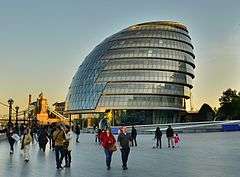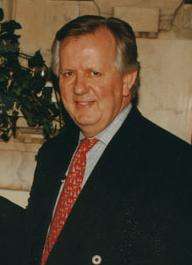London mayoral election, 2004
| | |||||||||||||||||||||||||||||||||||||||||||||||
| |||||||||||||||||||||||||||||||||||||||||||||||
| |||||||||||||||||||||||||||||||||||||||||||||||

 | |||||||||||||||||||||||||||||||||||||||||||||||
| First preference votes by London borough. Blue boroughs are those with most first preference votes for Steven Norris and red those for Ken Livingstone. | |||||||||||||||||||||||||||||||||||||||||||||||
| |||||||||||||||||||||||||||||||||||||||||||||||
 |
| This article is part of a series on the politics and government of London |
|
|
The 2004 election to the post of Mayor of London took place on 10 June 2004. It was being held on the same day as other local elections and the UK part of the 2004 European Parliament elections, so Londoners had a total of five votes on three ballot papers. Polling opened at 07:00 local time, and closed at 22:00. See: UK elections, 2004. The Supplementary Vote system was used.
Ken Livingstone gained the Labour party's nomination on 2 January 2004, three weeks after being re-admitted the Labour Party, after deputy Mayor Nicky Gavron, the previous candidate-elect, stepped down in favour of Livingstone.
Results
| Mayor of London election 10 June 2004 [1] | |||||||
|---|---|---|---|---|---|---|---|
| Party | Candidate | 1st Round | % | 2nd Round | Total | First Round Votes Transfer Votes | |
| Labour | Ken Livingstone | 685,548 | 36.8% | 142,842 | 828,390 |
| |
| Conservative | Steven Norris | 542,423 | 29.1% | 124,757 | 667,180 |
| |
| Liberal Democrat | Simon Hughes | 284,647 | 15.3% |
| |||
| UKIP | Frank Maloney | 115,666 | 6.2% |
| |||
| Respect | Lindsey German | 61,731 | 3.3% |
| |||
| BNP | Julian Leppert | 58,407 | 3.1% |
| |||
| Green | Darren Johnson | 57,332 | 3.1% |
| |||
| Christian Peoples | Ram Gidoomal | 31,698 | 2.2% |
| |||
| Independent Working Class | Lorna Reid | 9,452 | 0.5% |
| |||
| Independent | Tammy Nagalingam | 6,692 | 0.4% |
| |||
| Labour gain from Independent | |||||||
- Turnout: 1,920,560 (36.95% -
 2.55%)
2.55%) - Electorate: 5,197,792
- As the ballot papers are counted electronically, totals for all second preferences are available, even though most did not contribute to the final result.
Summary of policies
From the Manifesto booklet
Ken Livingstone - Standing up for London
- continue recovery from two decades of neglect under the Conservatives
- continue the programme of increased neighbourhood policing
- cut crime and make streets, parks and public transport safer
- continue reducing traffic congestion by extending the Congestion Charge Zone
- extend improvements in bus services and delivering similar improvements to the rest of the transport system
- improve transport in outer London with better buses and new tram lines
- run the Tube later every Friday and Saturday night with a free service on New Year's Eve
- work with government and voluntary sector with a long-term aim that all parents have access to high quality, affordable childcare.
- build 30,000 new homes a year and continue providing affordable housing
- tackle air pollution, making London a Low Emission Zone with rigorous pollution standards for lorries, buses, coaches and taxis.
- provide free bus travel to under-18s in full-time education
- bring the Olympic Games to London in 2012
Steve Norris - For a Safer London
- cut crime, particularly street crime, vandalism and graffiti
- put more police officers on patrol rather than in cars or offices
- encourage "zero tolerance" for minor crimes like graffiti, vandalism and public drunkenness
- increase share of police officers assigned to outer London
- double funding of youth projects
- launch a New York-style ‘CompStat’ system to target and manage crime more effectively
- introduce free school buses for children at primary schools to cut congestion
- abolish the congestion charge
- run London Underground until 3am at weekends, install air conditioning and provide security guards at night
Simon Hughes - A New Mayor for a Greater London
- make London safer, easier and more liveable
- make London cleaner and greener
- continue and improve community policing
- improve public transport
- run the tube late for three nights per week
- make stations safer
- challenge the Labour government on Council Tax, the war in Iraq and student fees
- provide a strong voice for London, putting Londoners’ security and safety first
Frank Maloney - Stop the career politicians
- increase the number of police officers, decrease the amount of political correctness in policing and support victims of crime
- abolish the congestion charge, oppose speed cameras and speed humps
- create a 24-hour transport system and extend the London Underground to South East London
- put more conductors on buses and provide free bus travel for under- 18s on the way to school
- stop selling school playing fields, increasing funding for youth clubs and fund competitive sports for young people, including a London youth games
- fund mayoral scholarships for disadvantaged children to go to university
- allow business to open for 24 hours, and give assistance to businesses in deprived areas
- preserve and encourage all London’s street markets
- celebrate St George’s Day with an annual parade
- support the 2012 Olympic bid and other international events, marketing London internationally
- reduce the Mayor’s take of Council tax
- abolish the GLA
- campaign for a higher state pension and tighter immigration controls
- provide more affordable homes for young British people and regenerate council estates
Lindsey German - Londoners deserve Respect
- fight racism and discrimination
- oppose privatisation
- ensure a minimum wage in London of £7.40 per hours and London Weighting of £4,000 per annum
- scrap council tax
- reduce cost of public transport, limit tube fare to £1.00
- campaign for social justice and pension linked to earnings
- campaign against the war in Iraq and student fees
Julian Leppert
- scrap the bid for the 2012 Olympic Games, due to expense, pressure on transport and policing, and London’s track record of failing on prestige projects
- oppose further immigration, and the presence of asylum seekers in capital, as they are actually economic migrants
- reduce cost of housing and pressure for new homes by ending immigration
- increase wages in London by ending immigration
- provide two new orbital rail lines, or possibly a tram line
- abolish the congestion charge
- undertake a prestige project to build a new airport on an artificial island in the Thames Estuary with a high-speed rail link to central London, rather than extending Heathrow
- promote St George’s Day
Darren Johnson - Quality Life, Quality London
- reduce traffic by expanding the congestion charge
- provide an integrated transport system that is reliable, safe and publicly owned
- reduce speed limits
- provide better cycling facilities and safe pedestrian routes for every school,
- oppose privatisation and cutbacks
- protect parks, playing fields and open spaces and create 1,000 new allotment plots.
- work for Londoners, not big business
- work for an affordable London with action to end poverty, and end homelessness and poor housing with a new Housing for London Authority
- create jobs in green and creative industries, and in manufacturing
- work to breathe life into local economies and local shopping parades and high streets, and ensure provision of local services within walking distance
- put an end all forms of racism, sexism and homophobia
- make London safer by tackling fear, crime and its causes
- make solar panels compulsory for all new developments, expanding recycling and end incineration
- protect animal rights, wildlife and habitats
- press for an Air Traffic Congestion Charge, and an end to airport expansion and night flights
Ram Gidoomal
- deliver competence and accountability
- make London safer
- restore public confidence in the police and legal system
- ensure that new schools have a Christian or other faith-based foundation
- establish a £500 million London Regeneration Fund to bring new life and jobs to the capital.
- tackle the divide between rich and poor
- ensure London has a coherent, integrated transport system:
- bring Christian values of justice, integrity, compassion and reconciliation to London
- celebrate diversity as a source of strength
- be independent and not waste money
Lorna Reid - We live here too!
- give a political voice to the working class in London
- make the police answerable to local communities
- actively support local communities in tackling anti-social behaviour
- increase investment in youth projects facilities for young people
- increase investment in council housing, increase number of quality affordable homes
- abolish council tax in favour of a local income tax
- ensure a minimum wage of £7.32 for workers in London
- provide a publicly financed and accountable transport system and other public services
- oppose privatisation
- secure extra provision from central government to fund increased demand on local resources from immigration
- ensure regeneration schemes provide decent homes, jobs, and opportunities for everyone.
- tackle the lack of affordable child care and the failing education system
Tammy Nagalingam
- review and make changes to all aspects of public transport and provide best value for money to all
- limit Congestion charging to between 7 am and 9.30 am, and raise revenue by other means
- ban big lorries from central London between 6 am and 6 pm
- persuade councils not to have too many one way systems and too many road ramps in smaller roads, and sort out problems with bus lane and double yellow lines
- see that the environment does not cause health hazards
- help Borough councils on public health matters, saving the NHS money and cleaning-up the city
- donate 50% of the Mayor’s salary to improve public and environmental health
- provide sufficient funds for recruiting and training police officers
- provide better street lighting in alley-ways and corners of trouble spots, and get councils to provide CCTV in problem council estates and other problem areas
- celebrate St George’s Day in Hyde Park
- support the 2012 Olympics bid
- liaise with other organisations
Potential candidates
London-born comedian Lee Hurst seriously considered standing as a candidate in the election. His comedy club had been under threat of redevelopment, and this had re-ignited a spark of political ambition. His manifesto would probably have included policies such as scrapping bus lanes and the congestion charge, improving public transport (including the re-introduction of bus conductors and Routemaster buses), and tackling crime and abandoned cars.[2]
References
- ↑ "2004 election results for the Mayor of London and the London Assembly". London Elects. 10 June 2004. Retrieved 17 February 2013.
- ↑ "Comedian's mayoral ambition". BBC News. 3 October 2003. Retrieved 2007-09-06.
External links
- London Elects (official elections site): full results, all manifestos, detailed explanations of voting processes
- Guardian (newspaper): collection of manifestos
- MayorWatch London Elections Guide


